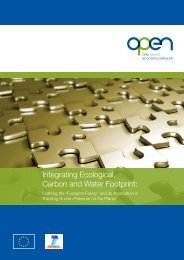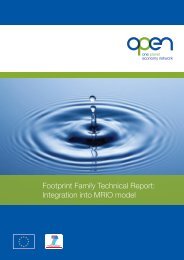OPEN: EU Scenario Storylines Report: - One Planet Economy Network
OPEN: EU Scenario Storylines Report: - One Planet Economy Network
OPEN: EU Scenario Storylines Report: - One Planet Economy Network
Create successful ePaper yourself
Turn your PDF publications into a flip-book with our unique Google optimized e-Paper software.
Agriculture and land use<br />
� Major CAP Reform. 9 Direct payments more equitably distributed among <strong>EU</strong><br />
Member States, but significantly lower overall and only where the crop/animal<br />
product meets a carbon intensity performance standard. Significantly greater<br />
relaxation of trade barriers. Additional environmental service/benefit payment<br />
phased in by 2018.<br />
� Organic farming measures to achieve 75% organic production in the <strong>EU</strong>.<br />
By regulation the share of organic farming increased significantly, but less<br />
aggressively than in scenarios 1 and 4, by 2.2% every year (from 2007 baseline<br />
of 4.1% in the <strong>EU</strong> 27) to 28.6% in 2020 and up to 75% in 2050.<br />
Trade and geopolitics<br />
� Extra-<strong>EU</strong> investment in low carbon development. Large-scale investment<br />
early on (2015-2025) via robust funding mechanisms (akin to an enhanced Global<br />
Environment Facility (GEF)) in low carbon development and decarbonisation in<br />
emerging economies and developing countries had a major effect on decoupling<br />
economic growth from consumption of natural resources . A global governance<br />
structure has provided the framework through which private and public funds<br />
were mobilised, rather than at national level.<br />
� Zoning of global production. The <strong>EU</strong> introduced a policy of preferential trade<br />
with countries with the lowest footprint intensity for each product group.<br />
Combined with the technological efficiency breakthroughs, Europe‘s own<br />
manufacturing sector realised a ―green tech revolution‖ enabling <strong>EU</strong><br />
manufacturers to compete with cheaper, less green products from outside the <strong>EU</strong>.<br />
� Sustainable fish & fish products policy. Measures were taken to restrict<br />
imports of certain species or from countries with unsustainable fishing practices,<br />
including quotas and import bans of certain species, and a requirement that all<br />
imports of certain species contain certified sustainable fisheries eco-labelling<br />
(Measures coupled with generous sustainable fisheries foreign aid).<br />
9 In this scenario, the architecture of the CAP is conceptually in-line with Option 2 of the CAP Towards 2020 EC<br />
Com.<br />
Page 29 of 57





